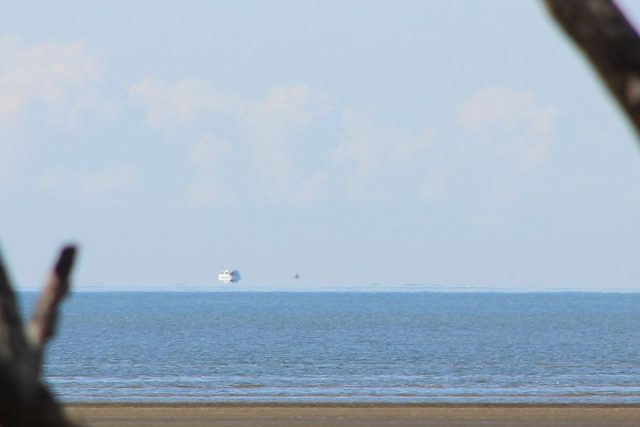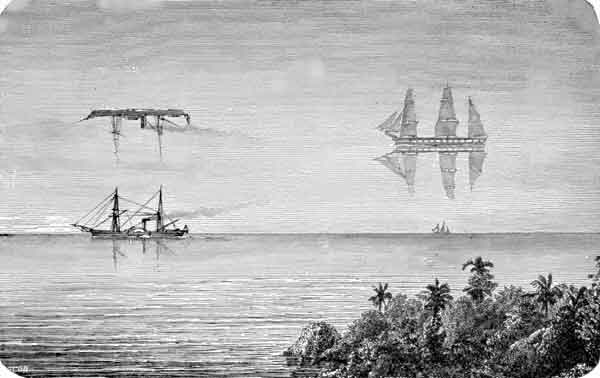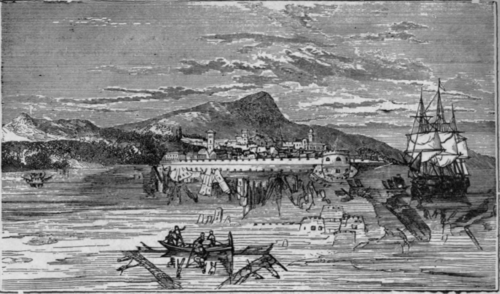There are weird occurrences on our planet that remain inexplicable just long enough to nurture all sorts of beliefs. Take for instance haunted houses. The reports of specters boomed in the Victorian era and the beginning of the 20th-century, a time when gas lamps were common.
The theory goes that long-term exposure to substances emitted from gas lamps, such as carbon monoxide, could have stimulated some people to experience hallucinations or hear a bump in the night.
Some knowledge of optics and how our atmosphere functions can help us explain a few more otherworldly experiences, such as the Tale of the Flying Dutchman which, according to folklore stories, is a ghost ship that never returns home, doomed to sail the open seas and oceans for infinity. As legend has it, the Flying Dutchman is usually spotted from afar, sometimes even radiating ghostly light.
One explanation is Fata Morgana.

Under certain specific conditions in the atmosphere, this optical illusion occurs in a narrow band of light just above the horizon. Fata Morgana is a type of superior mirage, meaning that the image appears above the actual object, which can actually take multiple distinct forms. Even when the vessel in the mirage does not seem to be dangled in the air, it still looks odd and out of this world.

Truth be told, with a Fata Morgana, it is not easy to say which individual segment of the mirage is real and which is not. Given a real ship is out of sight since it is already below the horizon line, a Fata Morgana can still generate an image of it, making it look slightly elevated. What the human eye catches is just a mirage. When the real ship is still above the horizon, the image of it can duplicate a couple of more times and be further distorted by a Fata Morgana. As in the case with the Flying Dutchman, the distorted image is also changeable, and the mirage itself may consist of several inverted and erect images piled on top of one another.
That certainly lead us to the question: what is Fata Morgana? In the beginning, it was nothing more than the Italian name for the famed Arthurian sorceress Mogan le Fay. A belief concerning mirages, which were often spotted in the Strait of Messina, a narrow passage in between Sicily and Calabria in the south of Italy, were allegedly attributed to her witchcraft. The mirage, thought to look like fairy castles soaring up in the air and also false land, was believed to be her spells to lure sailors to their death.

Nevertheless, Fata Morgana kept being used as a name of all superior and complex imagery that under certain conditions in nature are produced in a tight layer right above the horizon. It is an intricate optical phenomenon that happens as the rays of light progress through layers of air that have different temperatures.
Usually, Fata Morgana happens when the weather is calm, and a layer of significantly warmer air hangs over another layer containing cooler air, a phenomenon known as thermal inversion. In normal conditions, it is the other way round, the warmer air is usually closer to the surface of Earth. In the case of steep thermal inversion, an atmospheric duct may also form. The atmospheric duct then behaves as a refracting lens, subsequently producing both inverted and erect images, widely known as Fata Morgana.
When a Fata Morgana mirage occurs, it depicts a certain object, or even a few objects, which can appear as completely unrecognizable and mystical. The occurrence may happen on open sea and it can also be observed on land, especially in polar regions. The most famed notion of Fata Morgana is that of the imaginary cacti, in the endless desert.

The Fata Morgana object can be just anything, from ships to entire islands or coastlines. Intricate phenomena that can freely be attributed to Fata Morgana take place all the time, as when spectators report seeing UFOs. In this case, a Fata Morgana may actually display an object situated somewhere below the astronomical horizon. Subsequently, it makes the object look as if it was apparently hovering in the sky. It can also magnify it vertically, providing an entirely undefined look of the object.
In the 19th century, Fata Morgana images are believed to have been recorded in two distinct encounters of nonexistent land arctic masses. The first was the Croker Mountains, “discovered” by Sir John Ross. He was tricked in 1818 while conducting a voyage purposed to navigate the Northwest Passage, the connection between the northern Atlantic and Pacific Oceans.

As Ross’s ship arrived at Lancaster Sound in Canada, the passage should be straight ahead; however, he reported seeing a massive range of mountains out in the distance and so did not move in that direction. John Ross gave up his expedition. After his return to England, the existence of such mountains would soon be proven false, ruining his reputation as a sailor.
Almost nine decades after Ross’s voyage, Robert Peary would give the name Crocker Land to another stretch of land he believed he saw in the distance. The alleged spot was northwest of the highest point of Cape Thomas Hubbard, a headland of the northern Canadian territory of Nunavut. As you might easily guess, no land was at that location.
In 1913 Donald Baxter MacMillan set out, determined to find the Crocker Land and explore it. On April 21 that year, the crew eventually saw what resembled an enormous island on the horizon. However, one member of the expedition named Piugaattoq, who happened to be an Inuit hunter and very familiar with the area, explained it was just an illusion. He called the appearance a “Pook-jok.”

Still, MacMillan spent a few more days, passing 125 miles of dangerous sea ice, before he finally admitted he was tricked. Piugaattoq turned out to be right. No Crocker Land existed; it was just a mirage, most likely a Fata Morgana.
Plenty more Fata Morgana occurrences have dazzled many more people in the long course of history. In Antarctica or Greenland, this is an ever-occurring phenomenon. One hot spot in Greenland is the imaginary Fata Morgana Land, a phantom island that was first reported back in 1907. After failing to find this unusual island, on the northwest coast of Greenland, the notion of it was attributed to be a Fata Morgana of the Tobias Island.
It’s a strange world, isn’t it?
